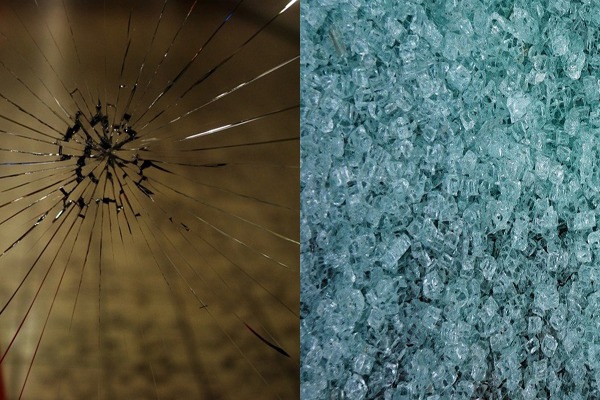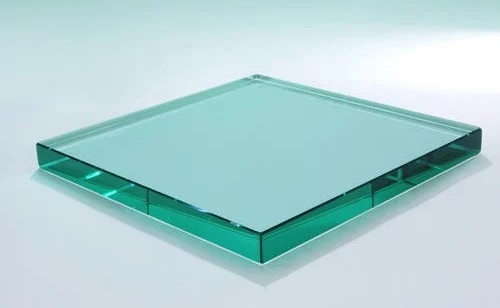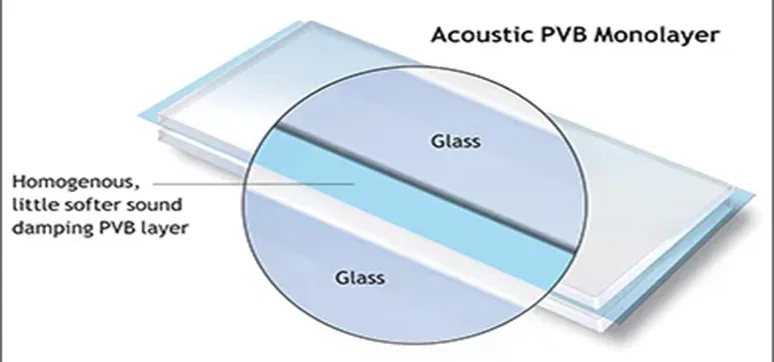Table of Contents
ToggleIntroduction

Laminated vs. Tempered Glass, When it comes to selecting the right type of glass for your project, Laminated vs. Tempered Glass which are two of the most common options. Both are classified as safety glass, meaning they are designed to minimize injury and damage when broken. However, they have significant differences in structure, strength, safety, and applications.
In this detailed guide, we’ll explore the differences, advantages, disadvantages, and best applications for Laminated vs. Tempered Glass, so you can make an informed decision based on your specific needs. Below here we are going to see brief about Laminated vs. Tempered Glass
What is Laminated Glass?

Laminated glass consists of two or more layers of glass bonded together with a plastic interlayer, typically polyvinyl butyral (PVB) or ethylene-vinyl acetate (EVA). This plastic layer holds the glass together, even when shattered.
How is Laminated Glass Made?
Two sheets of glass are placed with a PVB interlayer in between.
The assembly is heated and pressed to remove air bubbles and bond the layers.
It is then placed in an autoclave, which uses high pressure and heat to create a permanent bond.
Properties of Laminated Glass:
✅ Shatter Resistance – Remains intact even when broken
✅ Sound Insulation – Reduces noise pollution
✅ UV Protection – Blocks over 99% of harmful UV rays
✅ Security – Harder to break through, making it ideal for burglary prevention
What is Tempered Glass?

Tempered glass, also known as toughened glass, is a type of glass that has been heat-treated to increase its strength. It is four to five times stronger than regular glass.
How is Tempered Glass Made?
A regular glass sheet is cut to size.
It is heated to 620°C (1,148°F) in a tempering furnace.
The glass is then rapidly cooled (quenched) with high-pressure air blasts.
This process creates internal tension, making the glass much stronger and resistant to impact.
Properties of Tempered Glass:
✅ High Strength – Stronger than regular and laminated glass
✅ Heat Resistance – Withstands high temperatures
✅ Safety – Breaks into small, blunt pieces instead of sharp shards
✅ Affordability – Less expensive than laminated glass
Strength and Durability: Which One is Stronger?
The strength and Durability between Laminated vs. Tempered Glass are tabled below :
| Feature | Laminated Glass | Tempered Glass |
|---|---|---|
| Impact Resistance | Moderate | High |
| Shatter Resistance | High | Moderate |
| Heat Resistance | Moderate | High |
| Scratch Resistance | High | High |
| Durability in Extreme Weather | High | Moderate |
Tempered glass is much stronger than laminated glass in terms of impact resistance.
Laminated glass is more durable in extreme weather since it doesn’t shatter completely.
Safety Features: Which One is Safer?
Safety is one of the primary reasons people choose laminated or tempered glass. But they behave very differently when broken:
Laminated Glass Safety:
When broken, laminated glass stays intact due to the PVB interlayer.
It doesn’t shatter into dangerous shards, reducing the risk of injury.
Ideal for high-security areas, storefronts, and car windshields.
Tempered Glass Safety:
When tempered glass breaks, it shatters into small, dull-edged pieces, minimizing injury.
However, once broken, the entire sheet needs replacement.
Used in shower doors, side windows in cars, and glass railings.
🔎 Verdict: Laminated glass is safer in terms of breakage resistance, while tempered glass minimizes injury risks when broken.
This shows the safety measures between Laminated vs. Tempered Glass
Best Applications of Laminated Glass
Laminated glass is commonly used in places where safety, security, and noise reduction are important.
✅ Car Windshields – Prevents glass from shattering in an accident
✅ Hurricane and Storm-Resistant Windows – Ideal for areas with strong winds
✅ Bank and Storefront Security Glass – Harder to break through
✅ Soundproof Windows and Partitions – Reduces noise levels in offices and homes
Best Applications of Tempered Glass
Tempered glass is stronger and heat-resistant, making it ideal for high-impact areas.
✅ Shower Doors & Bathroom Partitions – Resistant to sudden temperature changes
✅ Car Side Windows – Designed to shatter into small, safe pieces upon impact
✅ Glass Railings & Balconies – High strength and safety
✅ Oven Doors & Fireplace Glass – Withstands high heat without breaking
The above are the application the shows the difference between Laminated vs. Tempered Glass
Cost Comparison: Which One is More Expensive?
| Feature | Laminated Glass | Tempered Glass |
|---|---|---|
| Manufacturing Cost | High | Moderate |
| Installation Cost | Higher | Lower |
| Repair & Replacement Cost | Lower (only damaged area replaced) | Higher (entire sheet replaced) |
💰 Tempered glass is generally cheaper than laminated glass. However, laminated glass is more cost-effective in the long run because it doesn’t need to be replaced entirely when damaged.
These are the cost comparison between Laminated vs. Tempered Glass
Other Key Differences

1. UV and Noise Protection
Laminated glass blocks over 99% of UV rays, preventing furniture and flooring from fading.
It also offers better sound insulation, reducing noise pollution significantly.
Tempered glass does not provide UV or noise protection.
2. Customization and Design Options
Laminated glass is available in various tints and colors.
Tempered glass cannot be cut or drilled after tempering, whereas laminated glass can be customized easily.
3. Environmental Impact
Tempered glass is easier to recycle, making it more environmentally friendly.
Laminated glass is harder to recycle because of the plastic interlayer.
These are the common key difference between Laminated vs. Tempered Glass as you can see.
Which One Should You Choose?
Choose Laminated Glass If You Need between Laminated vs. Tempered Glass:
✔️ Maximum security (anti-burglary and storm resistance)
✔️ Soundproofing and UV protection
✔️ A durable option for high-traffic or commercial spaces
Choose Tempered Glass If You Need:
✔️ Strength and impact resistance
✔️ A budget-friendly safety glass
✔️ Glass that can withstand high temperatures
Conclusion
Between Laminated vs. Tempered Glass Both have their strengths and weaknesses. The best choice depends on your priorities:
For security and sound insulation, go with laminated glass.
For strength, heat resistance, and affordability, tempered glass is the better option.
By understanding the key differences between these two types of glass, you can confidently choose the right one for your specific needs.
From this you can clearly identify the difference between Laminated vs. Tempered Glass
FAQs
Can laminated glass break easily?
No, laminated glass is designed to stay intact even when shattered.
Is tempered glass stronger than laminated glass?
Yes, tempered glass is stronger in terms of impact resistance. However, laminated glass provides better security since it holds together when broken.
Can I replace tempered glass with laminated glass?
It depends on the application. Tempered glass is required in areas where breakage could be dangerous, such as shower doors and vehicle side windows.
Which glass is better for home windows?
Laminated glass is better for windows as it offers security, soundproofing, and UV protection.
Is laminated glass energy efficient?
Yes! It helps reduce heat loss and blocks UV rays, making it a good insulator.
